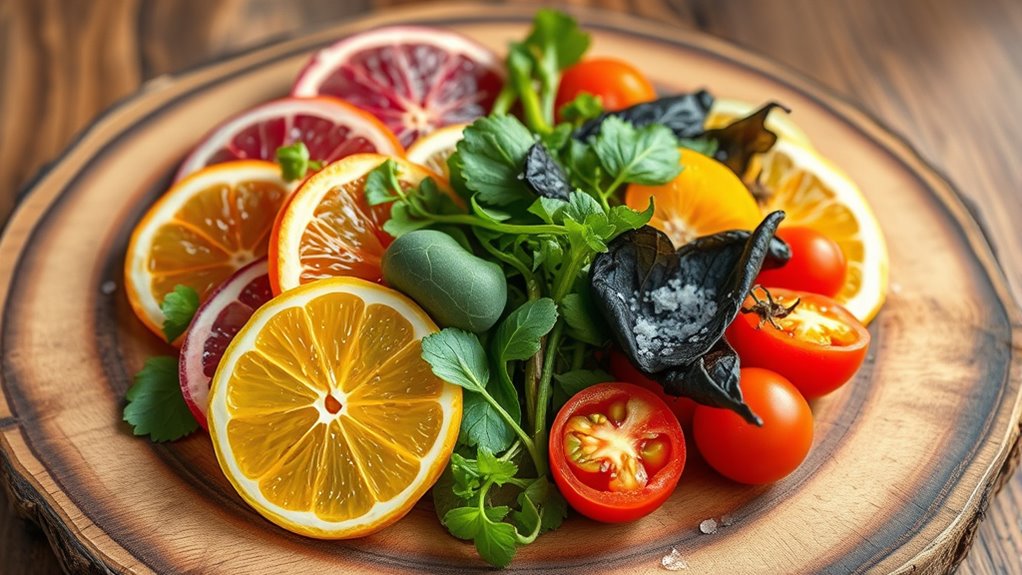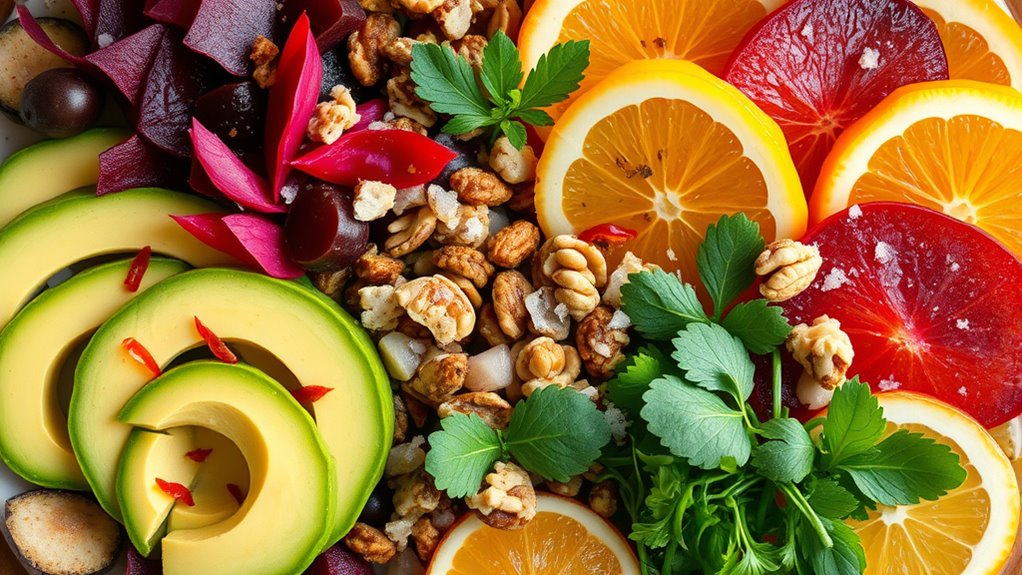To balance flavors in raw dishes, start by adjusting acidity through gentle acids like apple cider vinegar, ensuring it complements rather than overpowers. Incorporate healthy fats such as olive oil to enrich mouthfeel, and add a touch of sweetness with ripe fruits or honey to smooth bitterness. Use a pinch of salt to enhance overall taste and optimize flavor harmony. Fine-tuning these elements consistently will help you create well-rounded, delicious raw dishes—more tips await if you continue exploring.
Key Takeaways
- Use fermentation to naturally introduce acidity and complexity, enhancing flavor balance without overpowering other ingredients.
- Adjust acidity with milder substitutes like rice vinegar or apple cider vinegar to maintain harmony.
- Balance bitterness with natural sweetness from ripe fruits or honey to create a more palatable raw dish.
- Incorporate healthy fats like avocado or olive oil to enrich texture and carry flavors effectively.
- Fine-tune salt levels and flavor enhancers through tasting, ensuring all components work cohesively.

Have you ever bitten into a raw dish that feels off-balance, with flavors that clash or overwhelm? It’s a common experience, especially when you’re experimenting with raw ingredients and trying to hit that perfect harmony. Achieving this balance requires a good understanding of how each flavor component—acid, fat, sweet, bitter, and salt—interacts. The good news is that you can fine-tune these elements with simple adjustments, including fermentation techniques and ingredient substitutions, to elevate your dishes.
Balancing raw dishes involves understanding flavor interactions and using fermentation and substitutions for harmony.
Fermentation techniques are a powerful way to add depth and complexity to raw dishes. For instance, fermenting vegetables or fruits can introduce a subtle tang that naturally enhances acidity without the need for vinegar or citrus. This tang not only brightens flavors but also adds a layer of umami and complexity, making your dish more balanced. If you’re working with ingredients that seem too bland or flat, fermentation can provide a natural, probiotic boost that enriches the overall flavor profile. Plus, it’s flexible—you can experiment with different fermentation times and ingredients, like ginger, garlic, or chili, to create tailored flavor enhancements.
Ingredient substitutions are equally important when adjusting the balance. If your dish feels too acidic, swapping out overly pungent or sour elements for milder options can make a difference. For example, replacing lemon juice with a splash of rice vinegar or apple cider vinegar can subtly influence acidity levels. Similarly, if a dish is overly bitter, consider adding a touch of sweetness through ripe fruits or a drizzle of honey, which can mellow the bitterness and bring harmony. When it comes to fat, using healthier oils like avocado or extra-virgin olive oil can add richness without overwhelming other flavors. Salt, on the other hand, acts as a flavor enhancer; adjusting its quantity or trying different salts like sea salt or Himalayan pink salt can help fine-tune the overall taste.
Balancing flavors in raw dishes is an ongoing process of tasting and adjusting. It’s about understanding how each element influences the others and making small, deliberate changes. Incorporate fermentation techniques to deepen flavors naturally, and don’t hesitate to experiment with ingredient substitutions to achieve that perfect harmony. With practice, you’ll learn to anticipate how different components interact, creating raw dishes that are vibrant, well-rounded, and truly satisfying. Remember, the goal isn’t to eliminate all contrast but to craft a dynamic, cohesive flavor experience that delights the palate.
Frequently Asked Questions
How Can I Adjust Flavor Balance for Picky Eaters?
To adjust flavor balance for picky eaters, start with mild, familiar ingredients and use picky eater strategies like gradually introducing new flavors. Incorporate flavor masking techniques such as adding a touch of sweetness or fat to mellow strong tastes. Tweak acidity or salt carefully to enhance overall balance without overwhelming. Keep textures simple and presentation appealing to make the dish more inviting, encouraging them to try and enjoy new flavors.
What Are Common Mistakes When Balancing Raw Dish Flavors?
Be careful not to fall into common pitfalls when balancing raw dish flavors. You might over-season, overpowering subtle ingredients and masking freshness. Neglecting taste testing throughout the process can lead to imbalanced flavors that don’t harmonize. Always taste as you go, adjusting acidity, sweetness, salt, and fat carefully. Don’t rush; patience guarantees your dish strikes the perfect balance, delighting even the pickiest eaters with its harmonious flavors.
How Does Temperature Affect Flavor Perception in Raw Dishes?
Temperature greatly influences flavor perception in raw dishes, making certain tastes more or less prominent. When you serve your dish chilled, you’ll notice a sharper sensation of acidity and sweetness, while warmer temperatures can mellow flavors and enhance fat richness. Temperature affects your flavor sensitivity, so adjusting it helps balance the overall taste. Experiment with serving temperatures to highlight or soften specific flavors, creating a more harmonious and enjoyable raw dish.
Can Seasoning Substitutions Alter Flavor Balance?
Yes, seasoning substitutions can alter flavor balance markedly. When you swap out ingredients, you trigger flavor adaptation, which changes the dish’s overall taste profile. For example, replacing soy sauce with tamari adds a different saltiness, and swapping honey for agave introduces a subtle difference in sweetness. These adjustments may require you to tweak other seasonings to maintain harmony, ensuring your raw dish remains balanced and flavorful.
How Do Cultural Preferences Influence Flavor Balancing?
Ironically, your taste buds are often prisoners of cultural preferences, shaping how you balance flavors. Cultural taste preferences deeply influence your perception of regional flavor profiles, dictating whether you favor more acidity, saltiness, or sweetness. These preferences guide your seasoning choices, making flavor balancing a reflection of tradition rather than an absolute science. Embracing this diversity allows you to craft dishes that resonate authentically with different cultural palettes.
Conclusion
As you craft your raw dishes, picture a vibrant symphony on your plate, each flavor a different instrument working in harmony. A splash of acid brightens, a touch of fat adds richness, sweetness softens sharp edges, bitterness adds depth, and salt ties everything together like a subtle rhythm. When these elements dance perfectly, your dish becomes a colorful, tantalizing melody that excites every sense. Keep experimenting, and let your palate be the conductor of this delicious harmony.










